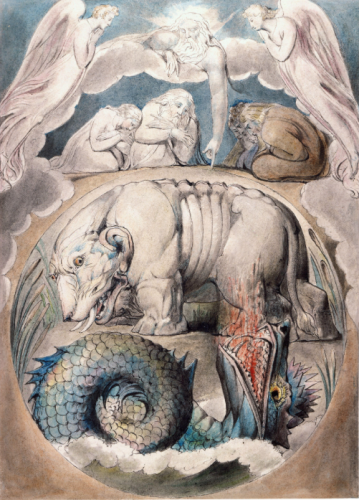vendredi, 24 mai 2019
Schmitt’s Blakean Vision of Leviathan and Behemoth

Schmitt’s Blakean Vision of Leviathan and Behemoth
Schmitt wrote The Leviathan in the State Theory of Thomas Hobbes (1938) in order to analyze the figure of the great Biblical fish leviathan as it figures as a symbol in Hobbes’ political theory. Part of the book consists of a genealogy of the leviathan as it appears in Western culture, from the Bible through to nineteenth-century English literature. From there, Schmitt delves into Hobbes’ political theory and its mechanistic core before providing a thoughtful assessment of the fate of continental liberalism and its decline in the early twentieth century.
Schmitt possessed a great deal of learning in many areas, including the history of European art and culture. His book on Hobbes, and its genealogy of the leviathan, allows Schmitt to display that learning. Of particular interest here is Schmitt’s wide reading in English literature from the Renaissance to the modern period. What follows is a long quote, but one that serves the purpose of helping us understand a hidden insight behind Schmitt’s appraisal of Hobbes’ political theory in the book. He explains:
The leviathan is cited a few times in Shakespeare’s dramas as a powerful, enormously strong, or quick sea monster, without any symbolism pointing toward the politico-mythical. Moreover, when he illustrates the unrestrained savagery of the plundering soldiers, as, for example, in the third act of Henry V, he gives no hint of medieval theological demonology or of a methaphysically determined enmity. Notwithstanding fanatical Bible-quoting writers, English literature was governed at the time of Hobbes’ Leviathan (around 1650) by a completely nonrnythical and nondemonic conception of the leviathan. The leviathan, it appears, was hardly suitable as an allegory in the style of the sixteenth and seventeenth centuries. For example, Milton did not attach any enigmatic symbolism to the leviathan in his Paradise Lost, depicting him as a huge sea monster. In a satirical-literary depiction of hell by Thomas Dekker, which was published for the first time in 1607, there appears a postillion of hell who explains its geography to a just deceased London miser and is characterized as a "lackey of that great leviathan." If I understand his depiction correctly, the leviathan is still the devil but not in the medieval-theological sense or in the sense of Dante's portrayal in The Inferno or even in the sense of Swedenborg's images of hell, but in a thoroughly literary-ironic sense and in the style and in the atmosphere of English wit. In Sanderson’s Sermons (II/310) of around 1630, God deals "with the great leviathans ofthe world." Here the leviathans are simply "the greats" of this world. This colloquial usage evolved further, permitting Burke (Works, VIll, 35) to speak of the Duke of Bedford as the "Leviathan of all the creatures of the Crown" and de Quincey (in 1839) of a lawsuit against such a powerful opponent as the "leviathan of two counties."
The leviathan finally becomes a humorous description of all sorts of unusually large and powerful men and things, houses, and ships. Slang, too, has appropriated this imposing word. Hobbes was undoubtedly responsible for exerting a specific influence on the colloquial usage of the word. I am not sure whether a place in Richard Ligon's History of the Island of Barbados, which reminds one of Hobbes' description, was actually influenced by him: "What produces harmony in that leviathan is a well-governed commonwealth." It is understandable why Locke, Hobbes' adversary. did not avoid the polemical usage of leviathan: "A Hobbist will answer: 'because the Leviathan will punish you, if you do not.'" Mandeville's fable about the bee (1714) speaks in a typically Hobbesian manner: "The gods decided that millions of you, well attached to each other, compose the strong leviathan."
 What is interesting about this extensive genealogy is the glaring omission of William Blake’s rendering of the leviathan (see above image, dated 1805). Some have associated the image with Schmitt — for instance, in this Internet edition of Land and Sea — and this association is even more interesting because Schmitt omits Blake’s work in this passage.
What is interesting about this extensive genealogy is the glaring omission of William Blake’s rendering of the leviathan (see above image, dated 1805). Some have associated the image with Schmitt — for instance, in this Internet edition of Land and Sea — and this association is even more interesting because Schmitt omits Blake’s work in this passage.
Immediately before this passage, Schmitt indicated that he was intersted in the leviathan in visual art, and discussed in particular the work of Bosch and Bruegel. In his discussion of English literature, he goes as far back as Shakespeare, and as far forward as de Quincey. Along the way, Schmitt touches on two of Blake’s major influences, Milton and Swedenborg, and even cites one of Blake’s immediate contemporaries: Edmund Burke. In the above passage, Schmitt reads around Blake very closely without naming him, even when the need is obvious.
A possible reason for this omission is that Blake’s image does not tell the story that Schmitt wishes to tell about Hobbes’ leviathan, but instead, it does points towards his own conception of the state, and his own vision of leviathan and behemoth. In the book, he criticizes Hobbes and his vision of the leviathan on a few grounds, and one of them is Hobbes’ mechanistic humanism. Hobbes’ brilliant insight was that all that was required for a human community to create a functioning state was to trade protection for obedience with a state that operates as an impersonal mechanism: the ‘leviathan.’ It seems like a simple trick, and is accomplished without religion — there can be a state church, for instance, or the state can tolerate varieties of belief, but ultimately it is the state that determines the place of religion in society. Following his experience with the English Civil War, Hobbes created the image of the behemoth to symbolize rebellion. Schmitt’s sees Hobbes’ symbols of leviathan and behemoth as being sharpened in the subsequent history of modernity, and to find themselves in mutated form in contemporary concepts of “state and revolution,” and Schmitt uses the phrasing of state and revolution to deliberately evoke the title of Lenin’s book by the same name.
Schmitt believed that the well-functioning state was not only determined by its order (which Hobbes’ state theory provides), but also by its orientation (which Hobbes’ theory does not provide), which has a religious or at least strong mythic basis. Schmitt’s state theory is more like the depiction of leviathan and behemoth in Blakes image. Hobbes was only concerned with the leviathan and behemoth as they contended in the terrestrial sphere, without any relationship to a transcendent realm or idea. To relate Hobbes’ theory to Blakes image is to see leviathan and behemoth contending solely within that sphere, as if we were to cut that sphere out of the picture and view it alone as a complete depiction of the state. Blake, however, includes above the terrestrial sphere a realm of God, angels, and other figures who look down on the terrestrial sphere with concern.
Because the liberal state, in Schmitt’s view, did not have a common orientation for everyone in that state, it eventually succumbed to private organizations with private orientations, particularly parties, churches, and trade unions. These indirect powers operating in the private sphere, Schmitt observes, have a tremendous advantage in the liberal state because they can mobilize power, and then act upon other individuals and groups, and even the state. As Schmitt says, “indirect” power works by masking (Schmitt uses the word “veil”) their power, which “enables them to carry out their actions under the guise of something other than politics — namely religion, culture, economy, or private matter — and still derive all the advantages of state.” As a result, private organizations in the liberal state “enjoy all the advantages and suffer none of the risks entailed with the possession of political power.” But private organizations in the liberal state enjoy this advantage in part because of the human need to seek orientations, which is ultimately the stronger element of Schmitt’s understanding of the state as order and orientation.
The human desire for orientation is can be satisfied by a private organization or by inward withdrawl. This withdrawl acts upon the liberal state in its own way, by becoming what Schmitt calls a “counterforce of silence and stillness.” Mystical withdrawal is perhaps one way to view at least some of the figures in Blake’s image: in particular, those that sit with God and amongst the angels, looking down with concern.
00:58 Publié dans Philosophie, Révolution conservatrice, Théorie politique | Lien permanent | Commentaires (0) | Tags : philosophie, léviathan, béhémoth, philosophie politique, carl schmitt, révolution conservatrice, théorie politique, politologie, sciences politiques |  |
|  del.icio.us |
del.icio.us |  |
|  Digg |
Digg | ![]() Facebook
Facebook



Les commentaires sont fermés.